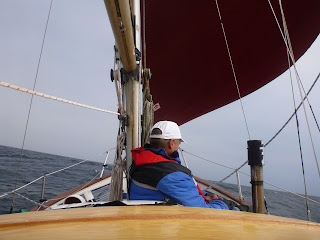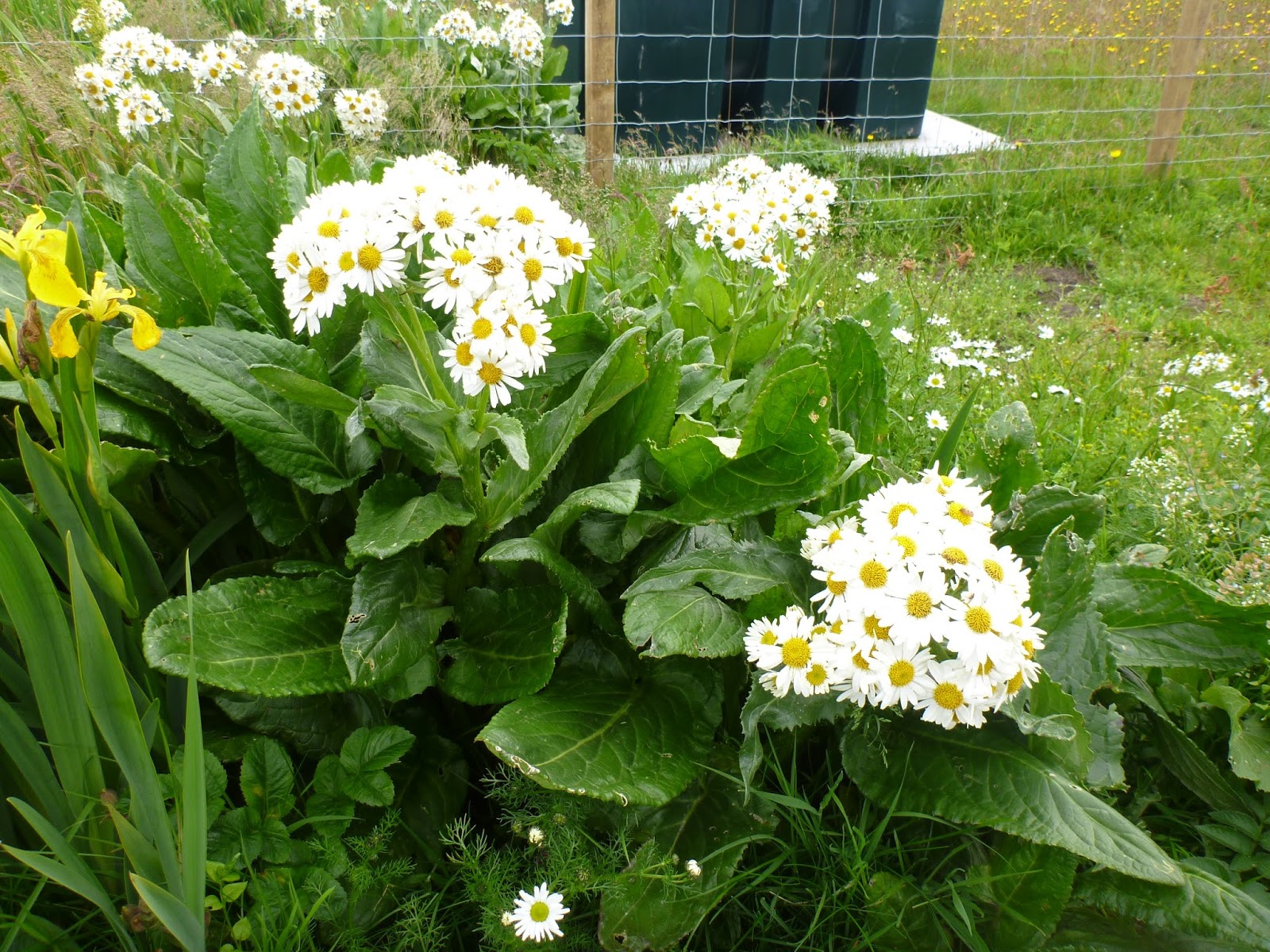Mercredi 17
juillet 2013
Nous mettons les
vélos à terre et allons visiter le petit musée local. La dame qui nous y
accueille est une ancienne institutrice qui sait beaucoup de choses et est
sympa. Elle nous raconte qu’il y avait 350 personnes qui vivaient ici
auparavant. Ils produisaient toute leur nourriture. Ils guettaient les navires
qui passaient et allaient, à la rame, leur proposer des produits frais (lait,
œufs, légumes …) et des tricots. Les
pulls de Fair Isle étaient renommés pour leur qualité. Une dame se joint à nous
quand nous discutons. Elle est très intéressée quand elle apprend qu’on est
venu en bateau. Nous l’invitons à déjeuner mais elle mange à l’observatoire.
Elle viendra après le lunch.
Je demande le nom
de la grande plante aux fleurs blanches. Oui, l’ancienne institutrice le sait.
C’est une « Magellan Ragwort ». C’est une plante originaire du sud du
Chili et du sud de l’Argentine et elle aurait été rapportée de là-bas par des
chasseurs de baleine.
Nous allons ensuite
voir le « South Harbour », qui n’a pas l’air du tout d’un harbour
(port) ! C’est plein de cailloux, peu profond … Il y a une petite jetée de
quelques mètres où c’est un peu plus profond mais je ne crois pas qu’elle est
très utilisée.
Judith, la dame,
arrive après le lunch. Elle a 78 ans, est australienne et voyage toute seule partout. Elle fait
partie d’une association qui s’appelle 5 W « Women of the World Welcome
Women of the World » (ou quelque chose comme ça), des femmes qui
accueillent des femmes. Elle est passionnée de voile qu’elle découvrit quand
elle avait 59 ans. A 65 ans elle voulait
à tout prix faire le tour du monde. Elle a trouvé un embarquement avec un
Américain de 71 ans. Il était bon marin mais tout à fait antipathique. Il l’a
fait travailler trois semaines sur le bateau avant d’embarquer des Etats-Unis
et en mer la traitait comme une esclave. Aux Azores, après 27 jours de
traversée, elle pense à le quitter mais décide d’attendre jusqu’en Irlande. Et
là elle abandonne le navire et le sale bonhomme ! Une sacrée bonne femme ! Et très sympa.
Incroyable, à 78 ans.
Nous allons, à
pied, voir des « puffins », macareux je crois, juste derrière où nous
sommes. Quel drôle d’oiseau. Ils volent les terriers des lapins et s’installent
dedans.
Puis nous allons,
en vélo, au phare nord. Nous voyons des colonies de « gannets » (fous
de Bassan), ces grands oiseaux magnifiques au visage comme maquillé. Leurs nids
sont serrés sur une espèce de plateau incliné sur un ilot.
Nous rentrons et
Jens fait le diner. Nous avons fait nos courses à la boutique ce matin.
Le Good Shepherd
IV est parti exceptionnellement ce matin : des touristes (et des iliens)
n’ont pas pu partir par avion à cause de brouillard à Lerwick donc il y a un
voyage extra du ferry. Mais il ne peut prendre que douze personnes.
Bonne journée,
appris un peu de l’histoire de Fair Isle, vu pleins d’oiseaux, fait un bon tour
en vélo et fait la connaissance d’une
femme exceptionnelle.
La météo est
bonne pour demain, on part sans doute.
Wednesday, July 17,
2013
We put the bike on
land, ride south and visit the small local museum. The lady who shows us the
museum is a former teacher who knows a lot, and is nice. She tells us that
there were 350 people who lived here before. They produce all their food. They
watched the passing ships and went to them, rowing, to offer their fresh
products (milk, eggs, vegetables ...) and knitwear. Fair
Isle sweaters were renowned for their quality. A lady joins us
when we talk. She is very interested when she learns that we came by boat. We
invite herto lunch but she eats at the observatory. She will come after lunch.
I ask the name of the
tall plant with white flowers. Yes, the old teacher knows it. It is a "Magellan
Ragwort". It is native from southern Chile
and southern Argentina
and have been brought her by whalers.
We then see the "South Harbour"
which did not seem at all a harbor (port)! It's full of rocks, shallow ...
There is a small pier, a few meters long where it is a little deeper, but I do
not think it is much used.
Judith, the lady,
arrives after lunch. She is 78 years old, Australian and travels alone everywhere. She
is a member of an association called 5 W "Women of the World Welcome Women
of the World" (or something like that), women who welcome women. She is
passionate about sailing, which she
discovered when she was 59 years old. At 65 she was eager to sail around the
world. She then found a 71 old American who was looking for a crew. He was a
good sailor but quite unfriendly. He made her work for three weeks on the boat
before boarding from the U.S.
and offshore treated her like a slave. On the Azores, after 27 days at sea, she
thinks about leaving him but decided to wait until Ireland. And then she left the ship
and the bad man! Quite a woman! And very nice. Incredible at 78 years.
We walk, to see puffins,
just behind where we are. What a funny bird. They steal burrows from rabbits
and live in them.
Then we ride, to the north
lighthouse. We see colonies of "gannets", these big beautiful birds with
“makeup”. Their nests are all close together on a sort of inclined plateau on a
little island.
We go back and Jens
made dinner. We did our shopping in the store this morning.
The Good Shepherd IV
went exceptionally this morning, tourists (and islanders) were not able to go
by plane because of fog at Lerwick so there is an extra ferry. But she can take
only twelve people.
A good day, we learned
a bit about the history of Fair Isle, we have seen
many birds, we made a good bike ride and met a remarkable woman.
The weather forecast
is good, so it looks like we are going to start sailing home tomorrow.
Le musée
The museum
Le phare au sud de l'ile
The southern lighthouse
L'aéroport
The airport
La plante/ the plant "Magellan Ragwort" (Senecio Smithii)
Judith
Macareux
Puffins
Le phare au nord
The northern lighthouse
Tout le blanc sont des nids de fous de bassan
All the white is gannets nests




































